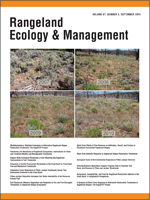Piñon (Pinus spp.) and juniper (Juniperus spp.) removal is a common management approach to restore sagebrush (Artemisia spp.) vegetation in areas experiencing woodland expansion. Because many management treatments are conducted to benefit sagebrush-obligate birds, we surveyed bird communities to assess treatment effectiveness in establishing sagebrush bird communities at study sites in Utah, Nevada, Idaho, and Oregon. Our analyses included data from 1 or 2 yr prior to prescribed fire or mechanical treatment and 3 to 5 yr posttreatment. We used detrended correspondence analysis to 1) identify primary patterns of bird communities surveyed from 2006 to 2011 at point transects, 2) estimate ecological scale of change needed to achieve treatment objectives from the relative dissimilarity of survey points to the ordination region delineating sagebrush bird communities, and 3) measure changes in pre- and posttreatment bird communities. Birds associated with sagebrush, woodlands, and ecotones were detected on our surveys; increased dissimilarity of survey points to the sagebrush bird community was characterized by a gradient of increased juniper and decreased sagebrush cover. Prescribed fires burned between 30% and 97% of our bird survey points. However, from 6% to 24% cover of piñon-juniper still remained posttreatment on the four treatment plots. We measured only slight changes in bird communities, which responded primarily to current vegetation rather than relative amount of change from pretreatment vegetation structure. Bird communities at survey points located at greater ecological scales from the sagebrush bird community changed least and will require more significant impact to achieve changes. Sagebrush bird communities were established at only two survey points, which were adjacent to a larger sagebrush landscape and following almost complete juniper removal by mechanical treatment. Our results indicate that management treatments that leave residual woodland cover and are not adjacent to extensive sagebrush stands are unlikely to establish sagebrush birds.
How to translate text using browser tools
1 September 2014
Ecological Scale of Bird Community Response to Piñon-Juniper Removal
Steven T. Knick,
Steven E. Hanser,
M. Leu
bird community
ecological scale
ordination
prescribed fire
sagebrush-obligate birds
woodland-sagebrush ecotone





